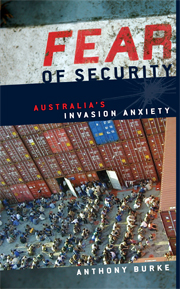Book contents
- Frontmatter
- Contents
- Preface and acknowledgements
- Abbreviations
- Introduction
- 1 Securing the Australian subject 1788–1918
- 2 Dreams of Pacific security 1919–45
- 3 Cold War against the Other 1946–69
- 4 Realpolitik beyond the Cold War 1970–95
- 5 Australia's Asian crisis 1996–2000
- 6 The wages of terror 2001–07
- Conclusion: A cosmopolitan future
- Notes
- Index
5 - Australia's Asian crisis 1996–2000
Published online by Cambridge University Press: 03 May 2010
- Frontmatter
- Contents
- Preface and acknowledgements
- Abbreviations
- Introduction
- 1 Securing the Australian subject 1788–1918
- 2 Dreams of Pacific security 1919–45
- 3 Cold War against the Other 1946–69
- 4 Realpolitik beyond the Cold War 1970–95
- 5 Australia's Asian crisis 1996–2000
- 6 The wages of terror 2001–07
- Conclusion: A cosmopolitan future
- Notes
- Index
Summary
National identity develops in an organic way over time.
John Howard, 13 December 1995On 2 March 1996 the Liberal-National Coalition returned to government with a stunning forty-five-seat majority in the House of Representatives – the worst defeat for Labor since 1977. The new Prime Minister, John Howard, said that he would govern for all Australians. While the scale of the defeat had many commentators searching for some kind of sea change in Australian consciousness, the Coalition's near-total loss of the same majority in 1998 revealed a new and dramatic political volatility in the electorate, whose elements were more difficult to locate and analyse. One suggestion, encouraged by Howard himself, was the subject of an ironic cartoon carried in The Australian. It showed an artist's studio, in which Howard could be seen standing before an easel and a tiny canvas, painting a suburban idyll. Through a door at the back of his studio a forlorn Keating could be seen following an attendant as he wheeled out a massive, impressionistic work entitled ‘The Big Picture’. On the wall of Howard's studio was a sign saying: ‘Australia's Top Miniaturist. Quiet Please’.
I read the text as directing the joke against Howard and those who elected his government, yet like all good satire, it also turned Keating's own hubris on him. An earlier version, printed two days before, had workmen carrying out Keating's canvas and asking a passer-by, ‘Excuse me mate, where's the big shredder?
- Type
- Chapter
- Information
- Fear of SecurityAustralia's Invasion Anxiety, pp. 169 - 206Publisher: Cambridge University PressPrint publication year: 2008



